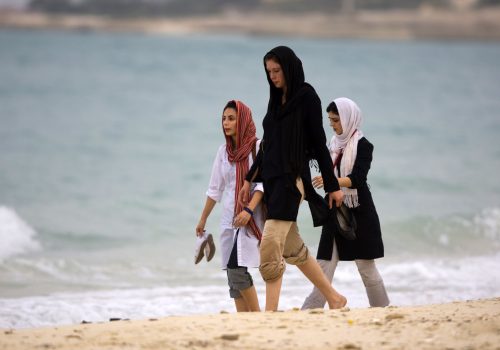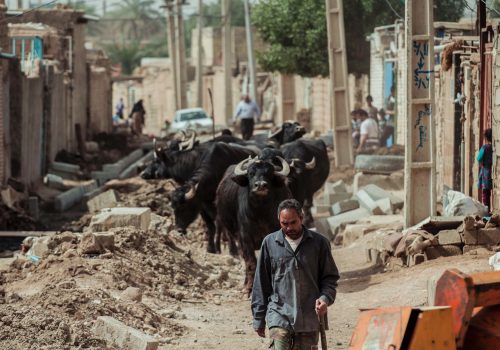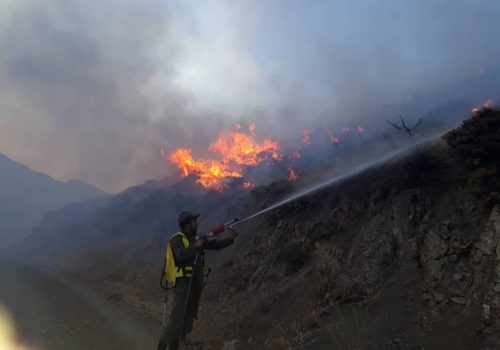Iran’s environmental woes could be Raisi’s Achilles heel
Among the challenges encountered by the Islamic Republic of Iran, climate change looms as one of the most serious, disrupting, and even life-threatening issues facing both rural and urban populations. This threat has worsened at a time when Iran is politically polarized, ideologically fractured, and economically embattled.
Iran’s biggest environmental concern used to be air pollution. More recently, however, water shortages and rising temperatures, as well as mismanagement and a lack of enforcement of existing environmental regulations, have greatly contributed to Iran’s environmental crisis.
Iran is confronting the drying up of rivers and wetlands, severe groundwater depletion, desertification, biodiversity reduction, air and soil pollution, poor waste management, soil erosion, destruction of pastures and forests, and dust storms. These difficulties are the result of several decades of policies and cannot be effectively tackled without a significant shift in both local and national approaches. Absent such adjustments, Iran is likely to experience more deadly political unrest in the coming years.
Environmental mismanagement led to protests in southwestern parts of the country in July, which has spread to several other provinces. At the heart of the unrest was water shortage in a region that used to be water rich. Esmaeil Kahrom, a well-known Iranian ecologist, told KhabarOnline news agency on July 20, “Khuzestan is one of the water-rich provinces of Iran, but unfortunately some unqualified individuals have been in charge, and the result is the current situation we face today.”
Somayeh Rafiei, the head of environmental affairs in the Iranian parliament, also criticized mismanagement of the country’s wetlands. “The main problem of water scarcity in Khuzestan and its related environmental issues, as well as the problems facing many other areas of the country, are the officials for whose past failures and inadequacies ordinary Iranians must pay a huge price today,” Rafiei said. Among the specific factors she cited were improper cultivation patterns, construction of dams by non-professionals, irregular transfer of water to other provinces, and destructive environmental industries such as oil, petrochemicals, and sugar cane.
Iran’s new president, Ebrahim Raisi, has been invited to the twenty-sixth United Nations (UN) Climate Change Conference in Glasgow, Scotland. The summit will bring leaders from more than seventy countries to expedite action toward accomplishing the goals set in the Paris Climate Accords and UN Framework Convention on Climate Change signed in 2016 by 195 nations. In general, however, Iranian administrations have neglected the issue of the environment and only begun to focus on it when it was perceived as threatening to the security of the ruling regime.
For example, in the debates prior to the June presidential elections, environmental issues took a backseat. Nevertheless, Raisi’s campaign did unveil an “environmental charter” outlining the need for sustainable development, better water management, natural resource management, waste management, public environmental education, watershed management and development of aquifer feeding plans, underground dams, rehabilitation and reconstruction of wetlands and lakes, and many other environmentally friendly policies. But it remains to be seen if these issues will actually be addressed.
Javad Heydarian, a prominent expert on environmental issues, told us that the environment is unlikely to be a top priority for the Raisi government, which has yet to name a head for Iran’sEnvironmental Protection Organization (IEPO) or to propose any specific environmental program. Comments by cabinet members regarding economic development, employment, self-sufficiency, and agriculture reveal how little they seem to know about the geography, climatology, hydrology, and other peculiarities of Iran’s ecological system. It is likely that Raisi will try to boost the economy and reduce unemployment through ill-conceived projects. It will be a major problem if a non-professional and incompetent person is assigned to lead the IEPO to develop more dams or roads.
Sadra Mohaqeq, a prominent Iranian journalist on environmental issues, told us that significant changes require action and support by bodies controlled by Iran’s Supreme Leader, Ayatollah Ali Khamenei. “Institutions under the Supreme Leader’s control must commit, both financially and from a policy standpoint, in order to effectively tackle the negative impacts of climate change,” Mohaqeq said.
The head of the IEPO must also compete with other ministries, such as oil, energy, roads, and urban development, which have much larger budgets and lobbying influence. Absent “a charismatic and dynamic head of IEPO,” Mohaqeq said, “these ministries, whose activities and programs are detrimental to the environment, will more than likely shape the government agenda.” An indication of the lack of seriousness of these ministers came when the new energy minister, Ali Akbar Mehrabian, was quoted as advising his staff to encourage people to pray for “rainfall.”
Yale University’s Environmental Performance Index shows that Iran lacks a fundamentally sound plan for meeting its environmental challenges. In its June 2020 report, which measured thirty-two indicators in 180 countries, Iran was ranked sixty-seventh with a score of forty-eight.
Another important issue is the Raisi government’s attitude toward the Paris Climate Accords. The previous parliament approved Iran’s entry into the accord, but the Guardian Council, a body of clerics and lawyers appointed directly or indirectly by the Supreme Leader, blocked passage of the law. The Council objected that Iran’s obligations were not fully specified and that Article 4 of the agreement would considerably limit the operations of Iran’s national industries.
At the Paris summit, Iran pledged to reduce its greenhouse gas emissions by 4 percent unconditionally and 8 percent if economic sanctions imposed by the US were lifted by 2030. Massoud Tajrishi, an environmental official under the previous administration, told the Islamic Republic News Agency (IRNA) in April that, in both the parliament and Guardian Council, “the process of joining and even implementing the commitment in this regard remained unresolved and vague…Iran has not officially and legally joined the Paris Agreement and therefore we have not taken any action in this regard so far.”
Heydarian added that, judging by the views expressed by some within the Raisi administration, “there is no positive attitude and narrative toward joining the Paris Climate Agreement and the ideological discrepancy resulting from ongoing tensions between the Islamic Republic of Iran and the West has overshadowed this agreement. Conservative elements within the government believe that, given Iran’s rich oil and gas resources, joining the agreement will hamper its development.”
The Raisi government, Heydarian told us, “Supports the view that the Paris Climate Agreement is a colonial agreement that raises the question of why Iran should commit to reducing greenhouse gases while Western countries have transited from the stage of consuming fossil fuels while reaching the desired level of developmental and economic stability.”
Mohaqeq said that it is safe to assume that joining the Paris Agreement by the Raisi administration has become inextricably linked to the outcome of the nuclear deal. “If significant progress is made in reviving the floundering 2015 nuclear talks and sanctions on Iran are lifted as a result, the Raisi administration might be willing to consider complying with the Paris Climate Agreement,” he said. “If, however, no progress is made in the talks and if the current sanctions remain in place, it is highly unlikely that the Raisi administration will abide by the Paris Climate Accords.”
For the time being, the Raisi administration has refrained from making any comments on the Paris Agreement. Historically, environmental issues have been of more interest to reformist presidents in light of their social base in the middle class. Raisi’s lack of support from the middle class may in part explain his administration’s lackadaisical attitude to environmental concerns except for issues that are perceived as posing a clear and present danger to the regime.
US sanctions have also clearly had an impact on Iran’s environmental problems by depressing Iran’s revenues, scaring off foreign investors in renewable energy, and bolstering arguments about the need for economic self-sufficiency. However, government mismanagement of water resources remains key. Over 90 percent of Iran’s water is used for agriculture, much of it for water-intensive crops like wheat, rice, and sugar cane.
Iran has failed to come up with methods to explore renewable energy applications and to mitigate greenhouse gas emissions. As long as the Raisi administration prioritizes ideology over practical solutions, the country will find itself in the constant and tight grip of protests in the coming years. If not properly tackled, the impacts of climate change are likely to spell disaster for Raisi’s presidency. Any leader who writes off climate change effects is setting themselves up for failure.
Javad Heiran-Nia is director of the Persian Gulf Studies at the Center for Scientific Research and Middle East Strategic Studies in Tehran.
Mahmood Monshipouri is professor and chair of international relations at San Francisco State University.
Image: Iranian-Arab youth talk to each other as they sit on a Karun riverbank at sunset in the city of Ahvaz 817Km (508 miles) south of Tehran in Khouzestan province amid the new coronavirus disease (COVID-19) outbreak in Iran on March 15, 2021. Ahvaz has marked black by the Government because of the number of the COVID-19 infected people. (Photo by Morteza Nikoubazl/NurPhoto)


